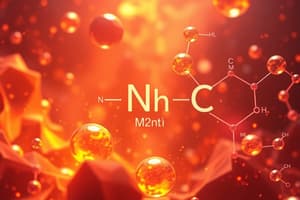Podcast
Questions and Answers
What causes a positive charge in an atom?
What causes a positive charge in an atom?
- An excess of electrons
- An equal number of protons and electrons
- A deficit of electrons (correct)
- An excess of neutrons
Which of the following particles is a negatively charged ion?
Which of the following particles is a negatively charged ion?
- SO₄²⁺
- Ca²⁺
- Cl⁻ (correct)
- Na⁺
What is the effect of molecular polarity in consumer products?
What is the effect of molecular polarity in consumer products?
- It enhances the caloric content of food
- It alters the smell of the products
- It increases the mass of the molecules
- It influences solubility and reactivity (correct)
Which type of force is responsible for the attraction between charged particles?
Which type of force is responsible for the attraction between charged particles?
What is the primary function of charged surfactants in detergents?
What is the primary function of charged surfactants in detergents?
Why is it important to understand the charges of materials when handling chemicals?
Why is it important to understand the charges of materials when handling chemicals?
Which of the following is a characteristic of cations?
Which of the following is a characteristic of cations?
What must consumer products containing charged substances comply with?
What must consumer products containing charged substances comply with?
Flashcards are hidden until you start studying
Study Notes
Charges in Consumer Chemistry
-
Definition of Charge:
- An electrical property of matter, indicating an excess or deficit of electrons.
-
Types of Charge:
- Positive Charge: Result of a deficit of electrons (more protons than electrons).
- Negative Charge: Result of an excess of electrons (more electrons than protons).
-
Atomic Structure:
- Atoms consist of protons (positive), electrons (negative), and neutrons (neutral).
- The balance of protons and electrons determines the overall charge of an atom.
-
Ionic Compounds:
- Formed when atoms transfer electrons, leading to charged ions.
- Cations: Positively charged ions (e.g., Na⁺, Ca²⁺).
- Anions: Negatively charged ions (e.g., Cl⁻, SO₄²⁻).
-
Molecular Polarity:
- Molecules can have a dipole moment if they have regions of partial positive and negative charge.
- Influences solubility, reactivity, and interactions with other substances.
-
Electrostatic Forces:
- Attract or repel charged particles.
- Important in the behavior of surfactants and emulsifiers in consumer products.
-
Applications in Consumer Products:
- Detergents: Use of charged surfactants to break down grease and stains.
- Cosmetics: Charged particles can influence texture and stability.
- Food Chemistry: Charged additives (e.g., preservatives) can affect taste and shelf life.
-
Safety and Charges:
- Awareness of charged materials is crucial for handling and storage of chemicals in consumer products.
- Electrostatic discharge can pose risks, especially in environments with flammable materials.
-
Regulatory Considerations:
- Consumer products containing charged substances must comply with safety standards and regulations to ensure public health.
Definition of Charge
- Charge is an electrical property of matter resulting from an imbalance of electrons, leading to either a surplus or shortage.
Types of Charge
- Positive charge occurs when there are more protons than electrons, indicating an electron deficit.
- Negative charge arises when electrons outnumber protons, creating an excess of negative charge.
Atomic Structure
- Atoms are composed of three primary subatomic particles: protons (positive), electrons (negative), and neutrons (neutral).
- The overall charge of an atom is determined by the balance between protons and electrons.
Ionic Compounds
- Ionic compounds result from the transfer of electrons between atoms, producing charged ions.
- Cations are positively charged ions, such as sodium (Na⁺) and calcium (Ca²⁺).
- Anions are negatively charged ions, including chloride (Cl⁻) and sulfate (SO₄²⁻).
Molecular Polarity
- Molecules exhibit a dipole moment when they contain distinct regions of positive and negative charge.
- Molecular polarity significantly affects solubility, chemical reactivity, and the nature of interactions between different substances.
Electrostatic Forces
- Electrostatic forces are responsible for the attraction or repulsion between charged particles.
- These forces play a crucial role in the function of surfactants and emulsifiers found in various consumer products.
Applications in Consumer Products
- Detergents utilize charged surfactants to effectively break down grease and stains on surfaces.
- In cosmetics, charged particles affect the texture, stability, and performance of products.
- Charged additives in food chemistry, such as preservatives, can impact flavor and extend the shelf life of food items.
Safety and Charges
- Understanding the nature of charged materials is vital for the safe handling and storage of chemicals in consumer products.
- Electrostatic discharge poses a hazard in environments containing flammable materials, necessitating careful management.
Regulatory Considerations
- Consumer products containing charged substances must adhere to established safety standards and regulations to safeguard public health and safety.
Studying That Suits You
Use AI to generate personalized quizzes and flashcards to suit your learning preferences.



